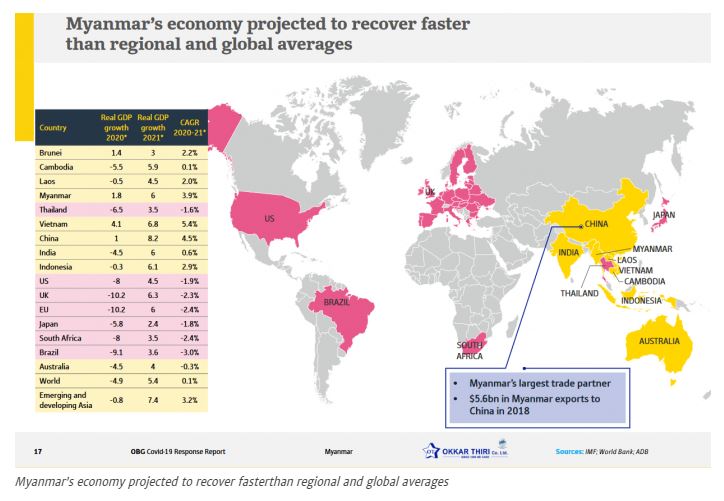Myanmar’s Economy to Rebounce Faster Than the Regional and Global Average
The Myanmar economy is projected to rebound faster than regional and global averages and will benefit from China’s relatively swift recovery, according to Oxford Business Group’s report called Covid-19 Response Report
(CRR) , produced in partnership with the medical equipment supplier Okkar Thiri.
While no economy remains immune to the negative effects of Covid-19, the IMF’s June 2020 outlook projects that Myanmar will be one of the few countries not to enter negative growth territory in 2020, with GDP growth accelerating to 6% the following year.
Another favorable factor is that its largest trade partner and second-largest source of FDI inflows – China – is also expected to outperform most other markets over the next 18 months, boding well for a recovery in both exports and investment
In addition, mass generosity also played, the report praised, a significant role in pandemic response as businesses and individuals donated significant amounts of money, medical supplies, and other necessities to support national efforts to combat the virus. Despite being a lower-middle-income country with a relatively low GDP per capita of $1408 in 2019, Myanmar has some of the most generous citizens in the world when it comes to donating money to charity, according to the World Giving Index 2019 from the UK-based Charities Aid Foundation.
“Although Myanmar remains a lower-middle-income country, its domestic and external debt remains at manageable levels, providing opportunities to scale up sustainable borrowing,” Oliver Cornock, OBG’s Editor-in-Chief, said. “Against this backdrop, our report shows that policymakers were able to implement key fiscal and monetary policies aimed at supporting the needs of the real economy, putting it on track to avoid negative growth in 2020 and recover faster than both regional and global averages.”

In April, the government released a Covid-19 Economic Relief Plan, a multifaceted approach to mitigate the economic challenges of Covid-19 and preparing to kick-start the recovery. One of its key goals is focused on nurturing the growth of innovative products and platforms, particularly in the realm of digital payments and e-commerce. Myanmar has a young, aspirational population of digital natives who could take advantage of targeted policy efforts and incentives to accelerate growth in these areas.
Although still below the highs of several years ago, FDI inflows grew in 2019 amid concerted efforts to liberalize key sectors and improve the business environment and regulatory framework. Notably, FDI has been flowing into productive sectors like manufacturing, livestock, and fisheries, which can spur job creation and export growth. The spike in FDI in the power sector this year can have a positive multiplier effect on growth in other sectors as the electricity supply improves.

The report also focuses on how health care infrastructure was scaled up when the pandemic hit, which not only helped to limit transmission and meet shifts in demand for treatment but will also support Myanmar’s plans to have a universal health care system in place by 2030.
Source: https://mmbiztoday.com/myanmars-economy-to-rebounce-faster-than-the-regional-and-global-average/


 English
English




